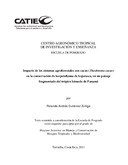| dc.contributor.advisor | Clerck, F. de | |
| dc.contributor.author | Gutiérrez Zúñiga, Rolando A. | |
| dc.contributor.other | CATIE - Centro Agronómico Tropical de Investigación y Enseñanza | |
| dc.date.accessioned | 2014-10-20T05:10:02Z | |
| dc.date.available | 2014-10-20T05:10:02Z | |
| dc.date.issued | 2011 | es_ES |
| dc.identifier.uri | https://repositorio.catie.ac.cr/handle/11554/5213 | |
| dc.description | Tesis (Mag.Sc.) - CATIE, Turrialba (Costa Rica), 2011 | es_ES |
| dc.description.abstract | En un paisaje protegido del Bosque Protector de Palo Seco, Panamá, dominado por sistemas agroforestales de cacao orgánico, se efectuó el muestreo de herpetofauna en 39 parcelas de 4 tipos de cobertura diferentes estructuralmente (cacao con árboles remanentes de bosque, cacao multiestrato diversificado, cacao con laurel y banano y bosque natural), con el fin de identificar las características estructurales y variables ambientales en cada tipo de cobertura que se relacionan con la abundancia, riqueza y diversidad de herpetofauna de hojarasca. Entender los regímenes de manejo típicos de la producción de cacao a través de las zonas neotropicales constituye un primer paso importante si queremos relacionar la producción de cultivos con la conservación de la biodiversidad. | es_ES |
| dc.description.abstract | We sampled herpetofauna diversity in 4 land uses (cocoa with remnant forest trees, cocoa diversified in multi layers, cocoa with laurel, bananas and natural forest) in the protected landscape of the Bosque Protector de Palo Seco, of Panamá. Our goal was to identify the structural characteristics and environmental variables of these land use types that contribute to the herpetofauna conservation. The area around the protected area is dominated by an organic cacao agroforestry systemsOur results should not be interpreted as meaning that cocoa can substitute natural forest, but suggests that it can provide habitat to herpetofauna communities, particularly, after abandonment. To understand the regimen of traditional management of cocoa production throughout the neotropic zone constitutes an important first step to relate the crop cultivation and the conservation of the biodiversity. | en_US |
| dc.language.iso | es | es_ES |
| dc.publisher | CATIE, Turrialba (Costa Rica) | es_ES |
| dc.relation.ispartof | Programa Agroambiental Mesoamericano (MAP). Fase I | |
| dc.rights | info:eu-repo/semantics/openAccess | |
| dc.subject | THEOBROMA CACAO | es_ES |
| dc.subject | BIODIVERSIDAD | es_ES |
| dc.subject | CONSERVACIÓN DE LA NATURALEZA | es_ES |
| dc.subject | AGROFORESTERIA | es_ES |
| dc.subject | HERPETOLOGÍA | es_ES |
| dc.subject | REPTILES | es_ES |
| dc.subject | ANFIBIOS | es_ES |
| dc.subject | COBERTURA VERDE | es_ES |
| dc.subject | TRÓPICOS HÚMEDOS | es_ES |
| dc.subject | PANAMÁ | es_ES |
| dc.subject.other | Sede Central | |
| dc.title | Impacto de los sistemas agroforestales con cacao (Theobroma cacao) en la conservación de herpetofauna de hojarasca, en un paisaje fragmentado del trópico húmedo de Panamá | es_ES |
| dc.type | Tesis de maestría | es_ES |
| dc.identifier.publication | Turrialba (Costa Rica) | es_ES |


